2007 ISUZU KB P190 battery
[x] Cancel search: batteryPage 3327 of 6020

Engine Management – V6 – Diagnostics Page 6C1-2–49
6 1 Connect the test lamp between the battery
voltage circuit of the ignition coil and to each
ground circuit of the ignition coil.
Does the test lamp illuminate at each ground circuit? —
Go to Step 8 Go to Step 10
7 1 Test the battery voltage circuit for an open or high
resistance at the splice of the affected bank of
ignition coils. Refer to 8A Electrical - Body and
Chassis for circuit testing procedures.
Did you find and correct the condition? —
Go to Step 12 Go to Step 10
8 1 Test for an intermittent and for a poor connection
at the ignition coil. Refer to 8A Electrical - Body
and Chassis for circuit testing procedures.
Did you find and correct the condition? —
Go to Step 12 Go to Step 11
9 NOTE
The battery voltage circuit is shared with
other components. Disconnecting a
component on the shared battery voltage
circuit may isolate a shorted component.
Review the electrical schematic and
diagnose the shared circuits and
components.
1 Repair a short to ground, an open or high resistance in the ignition 1 voltage circuit. Refer to
Refer to 8A Electrical - Body and Chassis for
wiring repair procedures.
2 Replace the fuse as necessary.
Did you complete the repair? —
Go to Step 12 —
10 1 Repair the open or high resistance in the ground
circuit. Refer to 8A Electrical - Body and Chassis
for wiring repair procedures.
Did you complete the repair? —
Go to Step 12 —
11 1 Replace the ignition coil. Refer to 2.15 Ignition
Coils, in 6C1-3 Engine Management – V6 –
Service Operations.
Did you complete the replacement? —
Go to Step 12 —
12 1 Connect all disconnected components.
2 Use Tech 2 to clear the DTC/s.
3 Start the engine.
4 Observe the Capture Info with Tech 2.
Do any of the misfire counters increment? —
Go to Step 2 Go to Step 13
13 1 Using Tech 2, select the DTC display function.
Does Tech 2 display any DTCs? — Go to the
appropriate DTC
Table in this Section System OK
When all diagnosis and repairs are completed, clear all DTCs and verify correct operation
BACK TO CHAPTER INDEX
TO MODEL INDEX
ISUZU KB P190 2007
Page 3338 of 6020
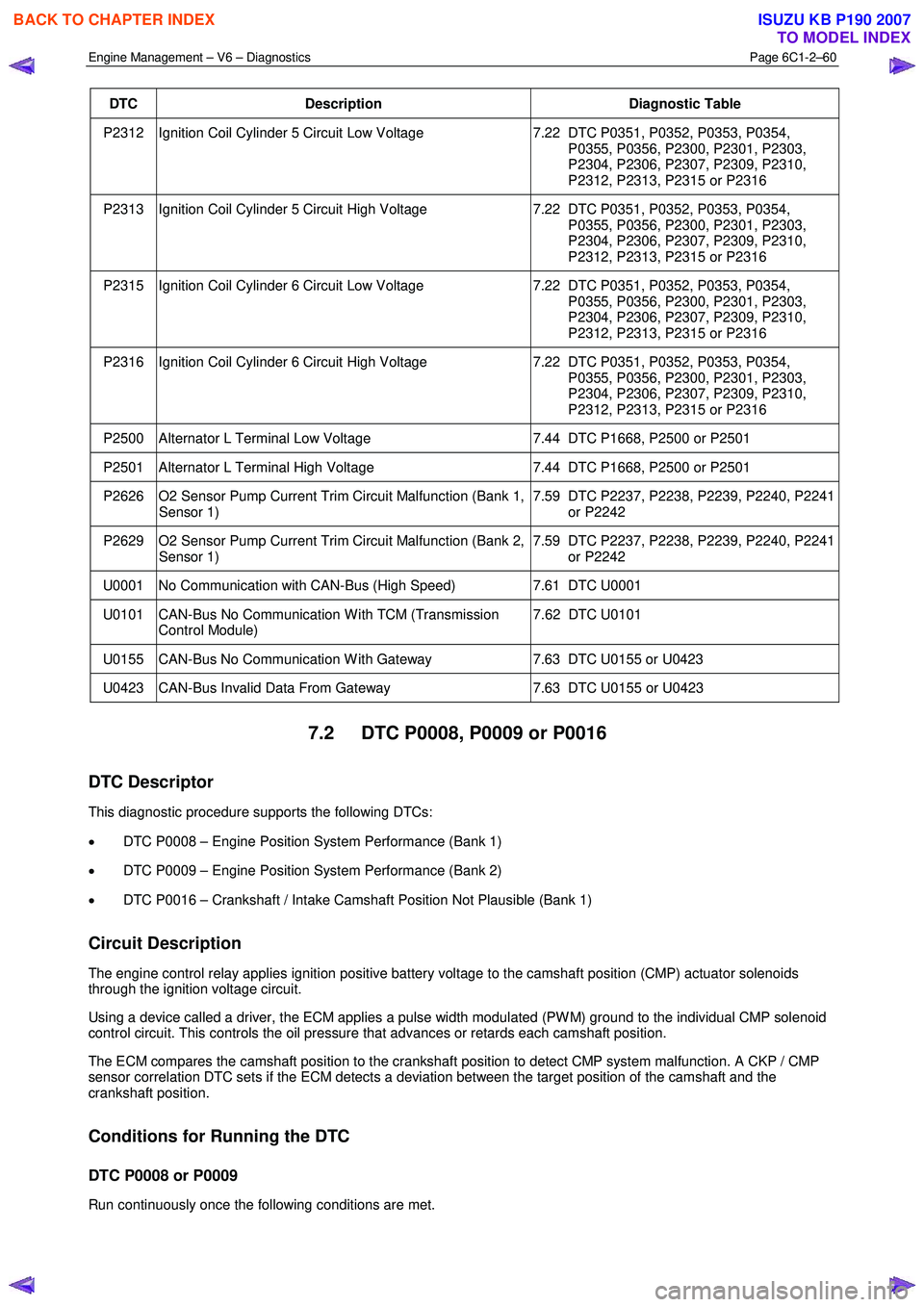
Engine Management – V6 – Diagnostics Page 6C1-2–60
DTC Description Diagnostic Table
P2312 Ignition Coil Cylinder 5 Circuit Low Voltage 7.22 DTC P0351, P0352, P0353, P0354,
P0355, P0356, P2300, P2301, P2303,
P2304, P2306, P2307, P2309, P2310,
P2312, P2313, P2315 or P2316
P2313 Ignition Coil Cylinder 5 Circuit High Voltage 7.22 DTC P0351, P0352, P0353, P0354,
P0355, P0356, P2300, P2301, P2303,
P2304, P2306, P2307, P2309, P2310,
P2312, P2313, P2315 or P2316
P2315 Ignition Coil Cylinder 6 Circuit Low Voltage 7.22 DTC P0351, P0352, P0353, P0354,
P0355, P0356, P2300, P2301, P2303,
P2304, P2306, P2307, P2309, P2310,
P2312, P2313, P2315 or P2316
P2316 Ignition Coil Cylinder 6 Circuit High Voltage 7.22 DTC P0351, P0352, P0353, P0354,
P0355, P0356, P2300, P2301, P2303,
P2304, P2306, P2307, P2309, P2310,
P2312, P2313, P2315 or P2316
P2500 Alternator L Terminal Low Voltage 7.44 DTC P1668, P2500 or P2501
P2501 Alternator L Terminal High Voltage 7.44 DTC P1668, P2500 or P2501
P2626 O2 Sensor Pump Current Trim Circuit Malfunction (Bank 1,
Sensor 1) 7.59 DTC P2237, P2238, P2239, P2240, P2241
or P2242
P2629 O2 Sensor Pump Current Trim Circuit Malfunction (Bank 2, Sensor 1) 7.59 DTC P2237, P2238, P2239, P2240, P2241
or P2242
U0001 No Communication with CAN-Bus (High Speed) 7.61 DTC U0001
U0101 CAN-Bus No Communication W ith TCM (Transmission
Control Module) 7.62 DTC U0101
U0155 CAN-Bus No Communication W ith Gateway
7.63 DTC U0155 or U0423
U0423 CAN-Bus Invalid Data From Gateway 7.63 DTC U0155 or U0423
7.2 DTC P0008, P0009 or P0016
DTC Descriptor
This diagnostic procedure supports the following DTCs:
• DTC P0008 – Engine Position System Performance (Bank 1)
• DTC P0009 – Engine Position System Performance (Bank 2)
• DTC P0016 – Crankshaft / Intake Camshaft Position Not Plausible (Bank 1)
Circuit Description
The engine control relay applies ignition positive battery voltage to the camshaft position (CMP) actuator solenoids
through the ignition voltage circuit.
Using a device called a driver, the ECM applies a pulse width modulated (PW M) ground to the individual CMP solenoid
control circuit. This controls the oil pressure that advances or retards each camshaft position.
The ECM compares the camshaft position to the crankshaft position to detect CMP system malfunction. A CKP / CMP
sensor correlation DTC sets if the ECM detects a deviation between the target position of the camshaft and the
crankshaft position.
Conditions for Running the DTC
DTC P0008 or P0009
Run continuously once the following conditions are met.
BACK TO CHAPTER INDEX
TO MODEL INDEX
ISUZU KB P190 2007
Page 3356 of 6020
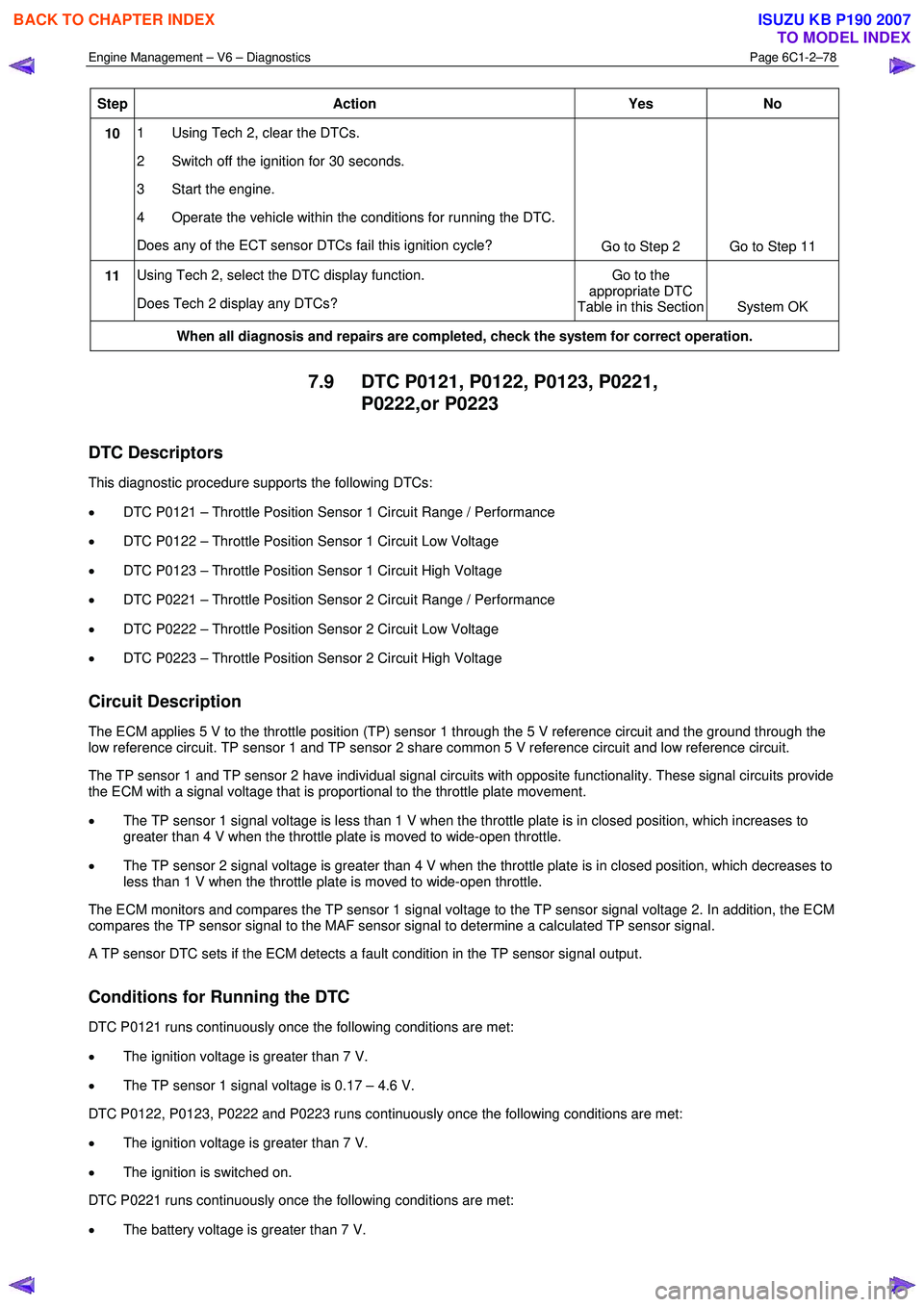
Engine Management – V6 – Diagnostics Page 6C1-2–78
Step Action Yes No
10 1 Using Tech 2, clear the DTCs.
2 Switch off the ignition for 30 seconds.
3 Start the engine.
4 Operate the vehicle within the conditions for running the DTC.
Does any of the ECT sensor DTCs fail this ignition cycle? Go to Step 2 Go to Step 11
11 Using Tech 2, select the DTC display function.
Does Tech 2 display any DTCs? Go to the
appropriate DTC
Table in this Section System OK
When all diagnosis and repairs are completed, check the system for correct operation.
7.9 DTC P0121, P0122, P0123, P0221,
P0222,or P0223
DTC Descriptors
This diagnostic procedure supports the following DTCs:
• DTC P0121 – Throttle Position Sensor 1 Circuit Range / Performance
• DTC P0122 – Throttle Position Sensor 1 Circuit Low Voltage
• DTC P0123 – Throttle Position Sensor 1 Circuit High Voltage
• DTC P0221 – Throttle Position Sensor 2 Circuit Range / Performance
• DTC P0222 – Throttle Position Sensor 2 Circuit Low Voltage
• DTC P0223 – Throttle Position Sensor 2 Circuit High Voltage
Circuit Description
The ECM applies 5 V to the throttle position (TP) sensor 1 through the 5 V reference circuit and the ground through the
low reference circuit. TP sensor 1 and TP sensor 2 share common 5 V reference circuit and low reference circuit.
The TP sensor 1 and TP sensor 2 have individual signal circuits with opposite functionality. These signal circuits provide
the ECM with a signal voltage that is proportional to the throttle plate movement.
• The TP sensor 1 signal voltage is less than 1 V when the throttle plate is in closed position, which increases to
greater than 4 V when the throttle plate is moved to wide-open throttle.
• The TP sensor 2 signal voltage is greater than 4 V when the throttle plate is in closed position, which decreases to
less than 1 V when the throttle plate is moved to wide-open throttle.
The ECM monitors and compares the TP sensor 1 signal voltage to the TP sensor signal voltage 2. In addition, the ECM
compares the TP sensor signal to the MAF sensor signal to determine a calculated TP sensor signal.
A TP sensor DTC sets if the ECM detects a fault condition in the TP sensor signal output.
Conditions for Running the DTC
DTC P0121 runs continuously once the following conditions are met:
• The ignition voltage is greater than 7 V.
• The TP sensor 1 signal voltage is 0.17 – 4.6 V.
DTC P0122, P0123, P0222 and P0223 runs continuously once the following conditions are met:
• The ignition voltage is greater than 7 V.
• The ignition is switched on.
DTC P0221 runs continuously once the following conditions are met:
• The battery voltage is greater than 7 V.
BACK TO CHAPTER INDEX
TO MODEL INDEX
ISUZU KB P190 2007
Page 3357 of 6020
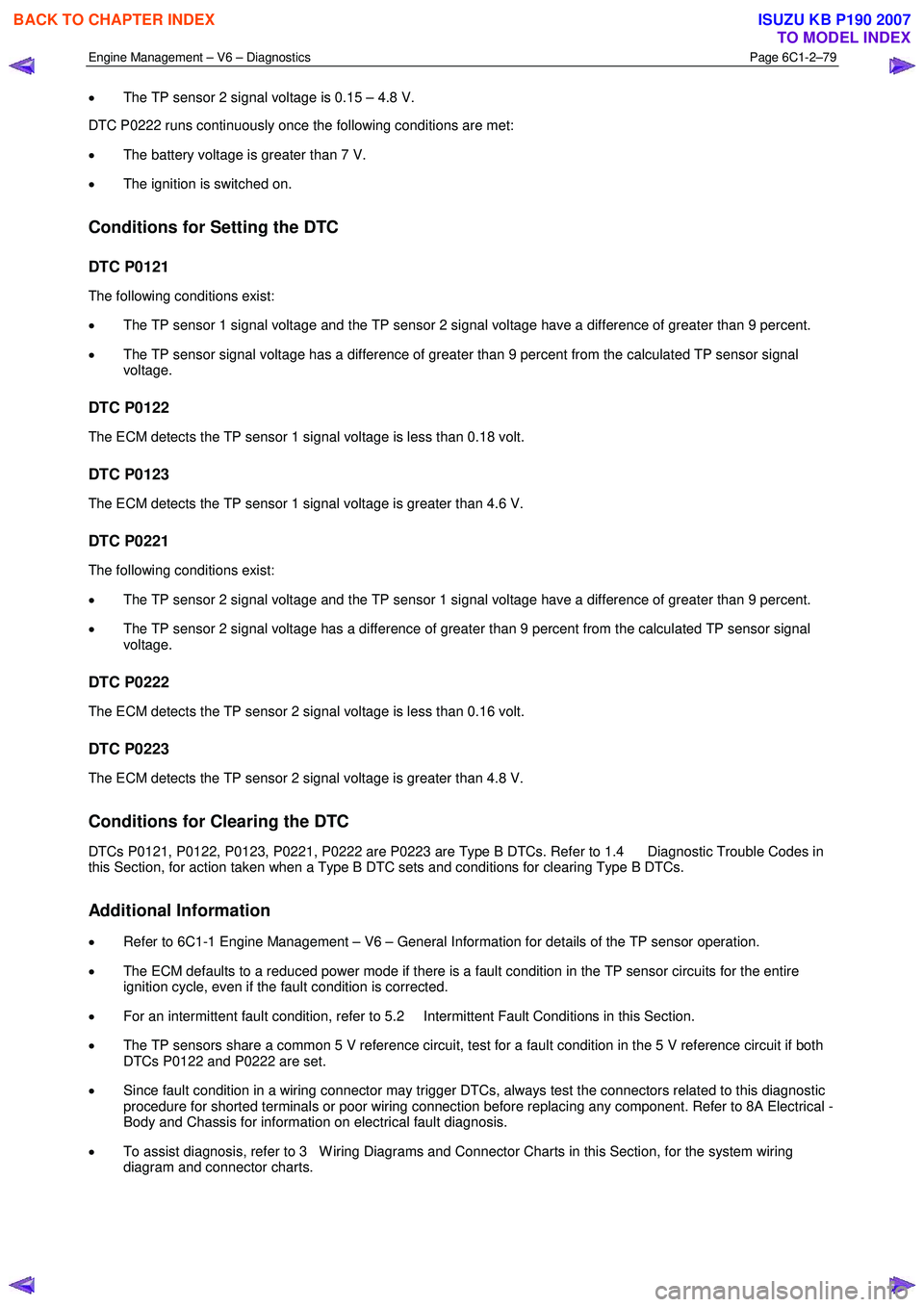
Engine Management – V6 – Diagnostics Page 6C1-2–79
• The TP sensor 2 signal voltage is 0.15 – 4.8 V.
DTC P0222 runs continuously once the following conditions are met:
• The battery voltage is greater than 7 V.
• The ignition is switched on.
Conditions for Setting the DTC
DTC P0121
The following conditions exist:
• The TP sensor 1 signal voltage and the TP sensor 2 signal voltage have a difference of greater than 9 percent.
• The TP sensor signal voltage has a difference of greater than 9 percent from the calculated TP sensor signal
voltage.
DTC P0122
The ECM detects the TP sensor 1 signal voltage is less than 0.18 volt.
DTC P0123
The ECM detects the TP sensor 1 signal voltage is greater than 4.6 V.
DTC P0221
The following conditions exist:
• The TP sensor 2 signal voltage and the TP sensor 1 signal voltage have a difference of greater than 9 percent.
• The TP sensor 2 signal voltage has a difference of greater than 9 percent from the calculated TP sensor signal
voltage.
DTC P0222
The ECM detects the TP sensor 2 signal voltage is less than 0.16 volt.
DTC P0223
The ECM detects the TP sensor 2 signal voltage is greater than 4.8 V.
Conditions for Clearing the DTC
DTCs P0121, P0122, P0123, P0221, P0222 are P0223 are Type B DTCs. Refer to 1.4 Diagnostic Trouble Codes in
this Section, for action taken when a Type B DTC sets and conditions for clearing Type B DTCs.
Additional Information
• Refer to 6C1-1 Engine Management – V6 – General Information for details of the TP sensor operation.
• The ECM defaults to a reduced power mode if there is a fault condition in the TP sensor circuits for the entire
ignition cycle, even if the fault condition is corrected.
• For an intermittent fault condition, refer to 5.2 Intermittent Fault Conditions in this Section.
• The TP sensors share a common 5 V reference circuit, test for a fault condition in the 5 V reference circuit if both
DTCs P0122 and P0222 are set.
• Since fault condition in a wiring connector may trigger DTCs, always test the connectors related to this diagnostic
procedure for shorted terminals or poor wiring connection before replacing any component. Refer to 8A Electrical -
Body and Chassis for information on electrical fault diagnosis.
• To assist diagnosis, refer to 3 W iring Diagrams and Connector Charts in this Section, for the system wiring
diagram and connector charts.
BACK TO CHAPTER INDEX
TO MODEL INDEX
ISUZU KB P190 2007
Page 3376 of 6020
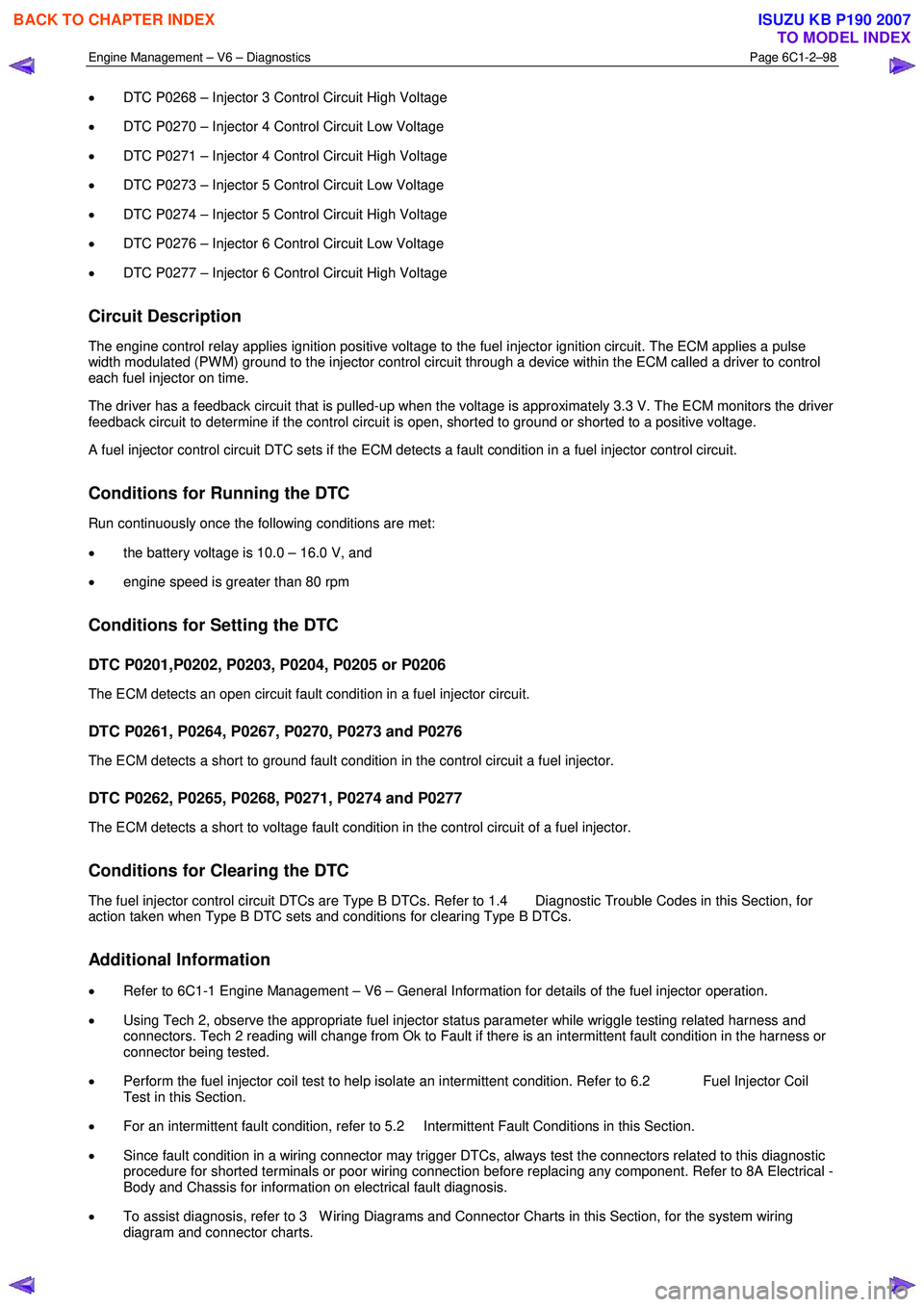
Engine Management – V6 – Diagnostics Page 6C1-2–98
• DTC P0268 – Injector 3 Control Circuit High Voltage
• DTC P0270 – Injector 4 Control Circuit Low Voltage
• DTC P0271 – Injector 4 Control Circuit High Voltage
• DTC P0273 – Injector 5 Control Circuit Low Voltage
• DTC P0274 – Injector 5 Control Circuit High Voltage
• DTC P0276 – Injector 6 Control Circuit Low Voltage
• DTC P0277 – Injector 6 Control Circuit High Voltage
Circuit Description
The engine control relay applies ignition positive voltage to the fuel injector ignition circuit. The ECM applies a pulse
width modulated (PW M) ground to the injector control circuit through a device within the ECM called a driver to control
each fuel injector on time.
The driver has a feedback circuit that is pulled-up when the voltage is approximately 3.3 V. The ECM monitors the driver
feedback circuit to determine if the control circuit is open, shorted to ground or shorted to a positive voltage.
A fuel injector control circuit DTC sets if the ECM detects a fault condition in a fuel injector control circuit.
Conditions for Running the DTC
Run continuously once the following conditions are met:
• the battery voltage is 10.0 – 16.0 V, and
• engine speed is greater than 80 rpm
Conditions for Setting the DTC
DTC P0201,P0202, P0203, P0204, P0205 or P0206
The ECM detects an open circuit fault condition in a fuel injector circuit.
DTC P0261, P0264, P0267, P0270, P0273 and P0276
The ECM detects a short to ground fault condition in the control circuit a fuel injector.
DTC P0262, P0265, P0268, P0271, P0274 and P0277
The ECM detects a short to voltage fault condition in the control circuit of a fuel injector.
Conditions for Clearing the DTC
The fuel injector control circuit DTCs are Type B DTCs. Refer to 1.4 Diagnostic Trouble Codes in this Section, for
action taken when Type B DTC sets and conditions for clearing Type B DTCs.
Additional Information
• Refer to 6C1-1 Engine Management – V6 – General Information for details of the fuel injector operation.
• Using Tech 2, observe the appropriate fuel injector status parameter while wriggle testing related harness and
connectors. Tech 2 reading will change from Ok to Fault if there is an intermittent fault condition in the harness or
connector being tested.
• Perform the fuel injector coil test to help isolate an intermittent condition. Refer to 6.2 Fuel Injector Coil
Test in this Section.
• For an intermittent fault condition, refer to 5.2 Intermittent Fault Conditions in this Section.
• Since fault condition in a wiring connector may trigger DTCs, always test the connectors related to this diagnostic
procedure for shorted terminals or poor wiring connection before replacing any component. Refer to 8A Electrical -
Body and Chassis for information on electrical fault diagnosis.
• To assist diagnosis, refer to 3 W iring Diagrams and Connector Charts in this Section, for the system wiring
diagram and connector charts.
BACK TO CHAPTER INDEX
TO MODEL INDEX
ISUZU KB P190 2007
Page 3397 of 6020
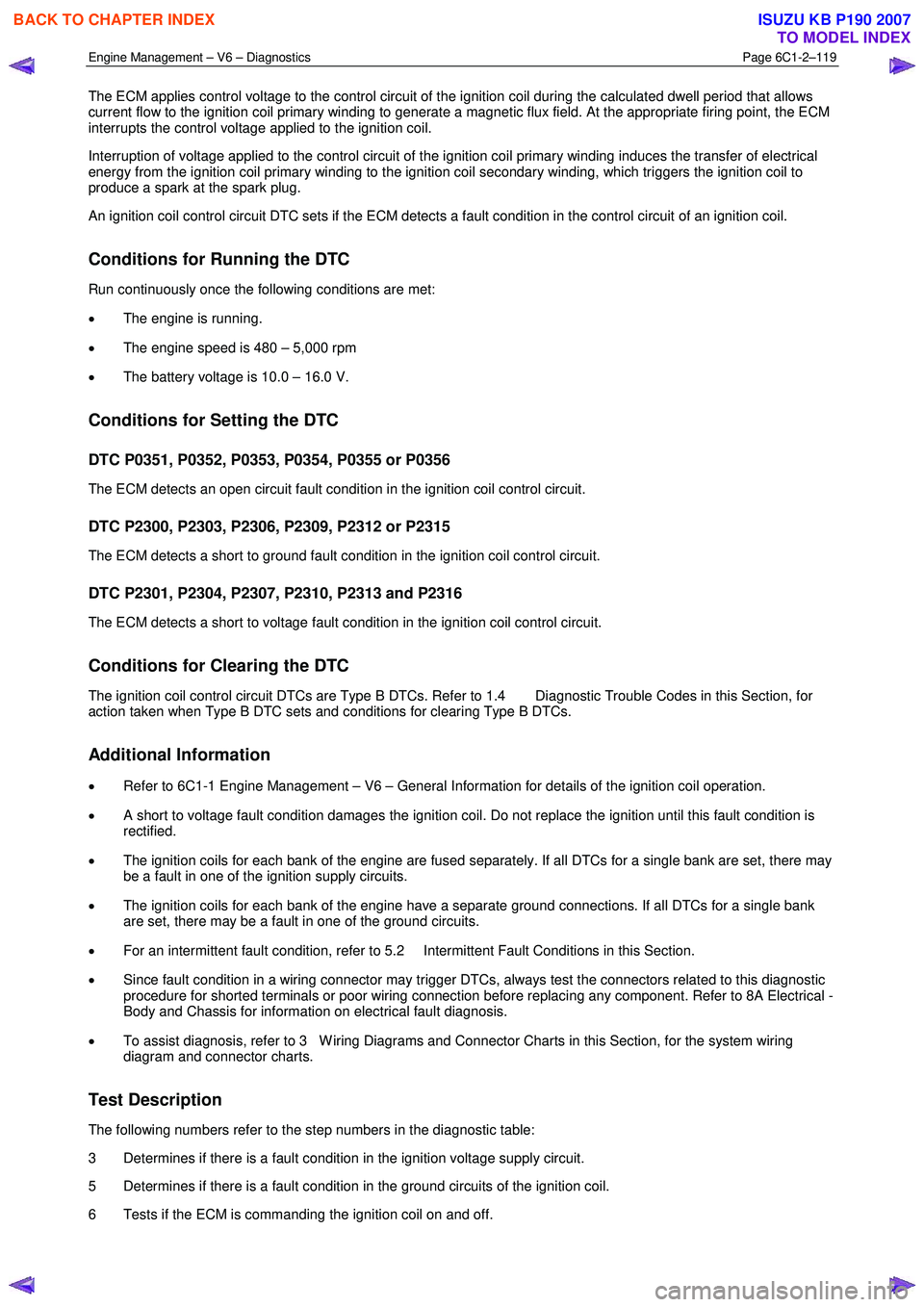
Engine Management – V6 – Diagnostics Page 6C1-2–119
The ECM applies control voltage to the control circuit of the ignition coil during the calculated dwell period that allows
current flow to the ignition coil primary winding to generate a magnetic flux field. At the appropriate firing point, the ECM
interrupts the control voltage applied to the ignition coil.
Interruption of voltage applied to the control circuit of the ignition coil primary winding induces the transfer of electrical
energy from the ignition coil primary winding to the ignition coil secondary winding, which triggers the ignition coil to
produce a spark at the spark plug.
An ignition coil control circuit DTC sets if the ECM detects a fault condition in the control circuit of an ignition coil.
Conditions for Running the DTC
Run continuously once the following conditions are met:
• The engine is running.
• The engine speed is 480 – 5,000 rpm
• The battery voltage is 10.0 – 16.0 V.
Conditions for Setting the DTC
DTC P0351, P0352, P0353, P0354, P0355 or P0356
The ECM detects an open circuit fault condition in the ignition coil control circuit.
DTC P2300, P2303, P2306, P2309, P2312 or P2315
The ECM detects a short to ground fault condition in the ignition coil control circuit.
DTC P2301, P2304, P2307, P2310, P2313 and P2316
The ECM detects a short to voltage fault condition in the ignition coil control circuit.
Conditions for Clearing the DTC
The ignition coil control circuit DTCs are Type B DTCs. Refer to 1.4 Diagnostic Trouble Codes in this Section, for
action taken when Type B DTC sets and conditions for clearing Type B DTCs.
Additional Information
• Refer to 6C1-1 Engine Management – V6 – General Information for details of the ignition coil operation.
• A short to voltage fault condition damages the ignition coil. Do not replace the ignition until this fault condition is
rectified.
• The ignition coils for each bank of the engine are fused separately. If all DTCs for a single bank are set, there may
be a fault in one of the ignition supply circuits.
• The ignition coils for each bank of the engine have a separate ground connections. If all DTCs for a single bank
are set, there may be a fault in one of the ground circuits.
• For an intermittent fault condition, refer to 5.2 Intermittent Fault Conditions in this Section.
• Since fault condition in a wiring connector may trigger DTCs, always test the connectors related to this diagnostic
procedure for shorted terminals or poor wiring connection before replacing any component. Refer to 8A Electrical -
Body and Chassis for information on electrical fault diagnosis.
• To assist diagnosis, refer to 3 W iring Diagrams and Connector Charts in this Section, for the system wiring
diagram and connector charts.
Test Description
The following numbers refer to the step numbers in the diagnostic table:
3 Determines if there is a fault condition in the ignition voltage supply circuit.
5 Determines if there is a fault condition in the ground circuits of the ignition coil.
6 Tests if the ECM is commanding the ignition coil on and off.
BACK TO CHAPTER INDEX
TO MODEL INDEX
ISUZU KB P190 2007
Page 3401 of 6020
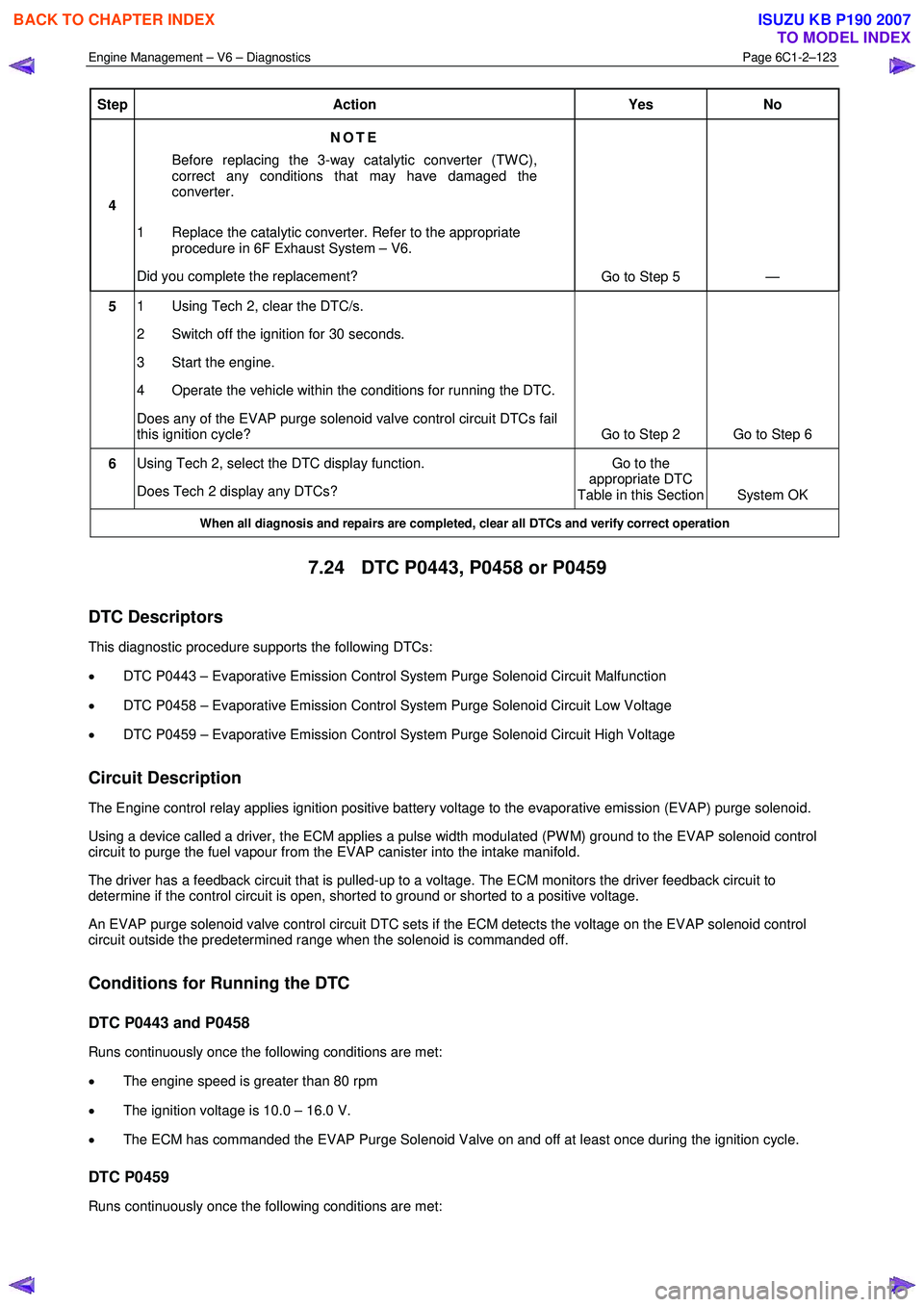
Engine Management – V6 – Diagnostics Page 6C1-2–123
Step Action Yes No
4 NOTE
Before replacing the 3-way catalytic converter (TW C),
correct any conditions that may have damaged the
converter.
1 Replace the catalytic converter. Refer to the appropriate procedure in 6F Exhaust System – V6.
Did you complete the replacement? Go to Step 5 —
5 1 Using Tech 2, clear the DTC/s.
2 Switch off the ignition for 30 seconds.
3 Start the engine.
4 Operate the vehicle within the conditions for running the DTC.
Does any of the EVAP purge solenoid valve control circuit DTCs fail
this ignition cycle? Go to Step 2 Go to Step 6
6 Using Tech 2, select the DTC display function.
Does Tech 2 display any DTCs? Go to the
appropriate DTC
Table in this Section System OK
When all diagnosis and repairs are completed, clear all DTCs and verify correct operation
7.24 DTC P0443, P0458 or P0459
DTC Descriptors
This diagnostic procedure supports the following DTCs:
• DTC P0443 – Evaporative Emission Control System Purge Solenoid Circuit Malfunction
• DTC P0458 – Evaporative Emission Control System Purge Solenoid Circuit Low Voltage
• DTC P0459 – Evaporative Emission Control System Purge Solenoid Circuit High Voltage
Circuit Description
The Engine control relay applies ignition positive battery voltage to the evaporative emission (EVAP) purge solenoid.
Using a device called a driver, the ECM applies a pulse width modulated (PW M) ground to the EVAP solenoid control
circuit to purge the fuel vapour from the EVAP canister into the intake manifold.
The driver has a feedback circuit that is pulled-up to a voltage. The ECM monitors the driver feedback circuit to
determine if the control circuit is open, shorted to ground or shorted to a positive voltage.
An EVAP purge solenoid valve control circuit DTC sets if the ECM detects the voltage on the EVAP solenoid control
circuit outside the predetermined range when the solenoid is commanded off.
Conditions for Running the DTC
DTC P0443 and P0458
Runs continuously once the following conditions are met:
• The engine speed is greater than 80 rpm
• The ignition voltage is 10.0 – 16.0 V.
• The ECM has commanded the EVAP Purge Solenoid Valve on and off at least once during the ignition cycle.
DTC P0459
Runs continuously once the following conditions are met:
BACK TO CHAPTER INDEX
TO MODEL INDEX
ISUZU KB P190 2007
Page 3406 of 6020
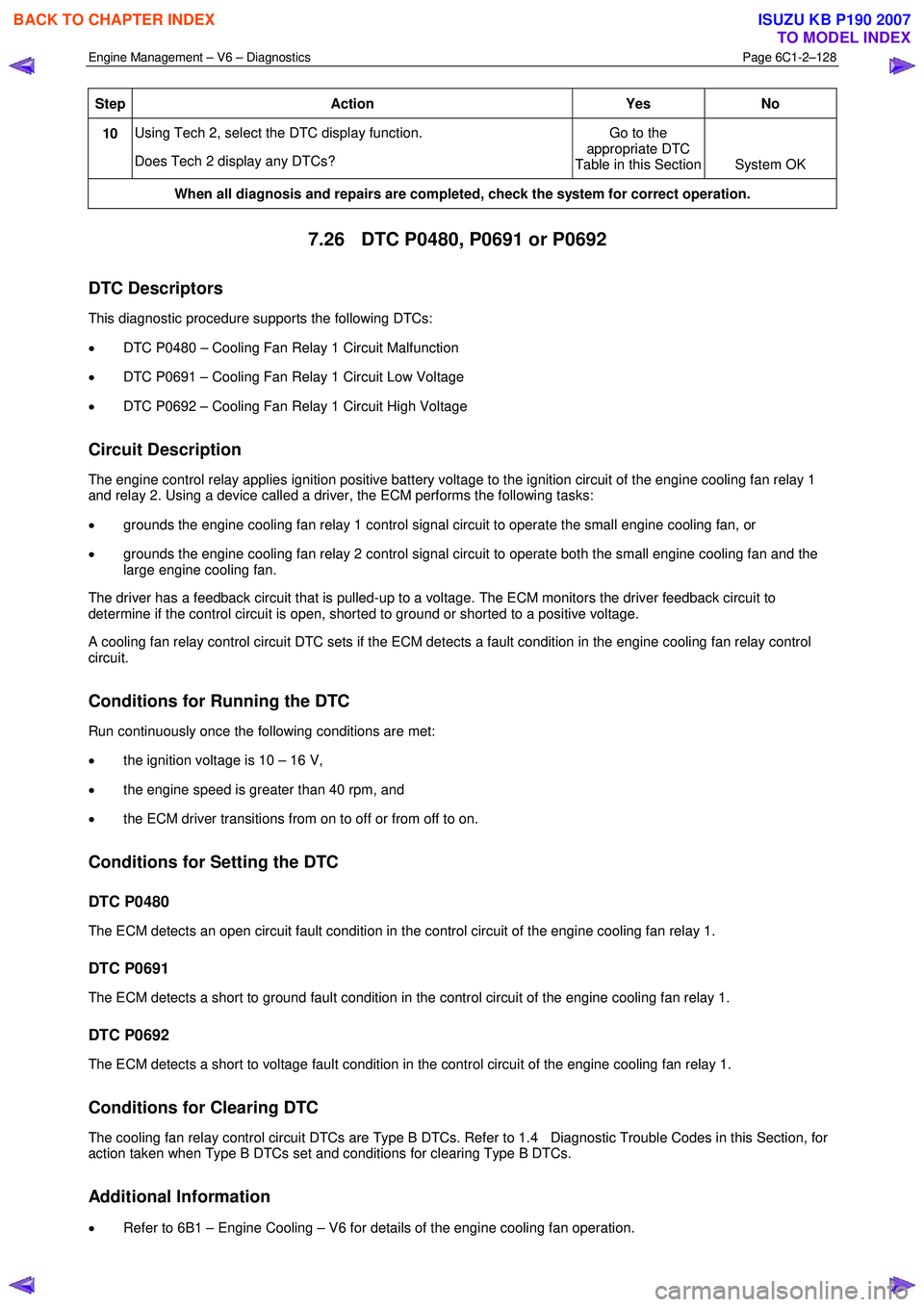
Engine Management – V6 – Diagnostics Page 6C1-2–128
Step Action Yes No
10 Using Tech 2, select the DTC display function.
Does Tech 2 display any DTCs? Go to the
appropriate DTC
Table in this Section System OK
When all diagnosis and repairs are completed, check the system for correct operation.
7.26 DTC P0480, P0691 or P0692
DTC Descriptors
This diagnostic procedure supports the following DTCs:
• DTC P0480 – Cooling Fan Relay 1 Circuit Malfunction
• DTC P0691 – Cooling Fan Relay 1 Circuit Low Voltage
• DTC P0692 – Cooling Fan Relay 1 Circuit High Voltage
Circuit Description
The engine control relay applies ignition positive battery voltage to the ignition circuit of the engine cooling fan relay 1
and relay 2. Using a device called a driver, the ECM performs the following tasks:
• grounds the engine cooling fan relay 1 control signal circuit to operate the small engine cooling fan, or
• grounds the engine cooling fan relay 2 control signal circuit to operate both the small engine cooling fan and the
large engine cooling fan.
The driver has a feedback circuit that is pulled-up to a voltage. The ECM monitors the driver feedback circuit to
determine if the control circuit is open, shorted to ground or shorted to a positive voltage.
A cooling fan relay control circuit DTC sets if the ECM detects a fault condition in the engine cooling fan relay control
circuit.
Conditions for Running the DTC
Run continuously once the following conditions are met:
• the ignition voltage is 10 – 16 V,
• the engine speed is greater than 40 rpm, and
• the ECM driver transitions from on to off or from off to on.
Conditions for Setting the DTC
DTC P0480
The ECM detects an open circuit fault condition in the control circuit of the engine cooling fan relay 1.
DTC P0691
The ECM detects a short to ground fault condition in the control circuit of the engine cooling fan relay 1.
DTC P0692
The ECM detects a short to voltage fault condition in the control circuit of the engine cooling fan relay 1.
Conditions for Clearing DTC
The cooling fan relay control circuit DTCs are Type B DTCs. Refer to 1.4 Diagnostic Trouble Codes in this Section, for
action taken when Type B DTCs set and conditions for clearing Type B DTCs.
Additional Information
• Refer to 6B1 – Engine Cooling – V6 for details of the engine cooling fan operation.
BACK TO CHAPTER INDEX
TO MODEL INDEX
ISUZU KB P190 2007